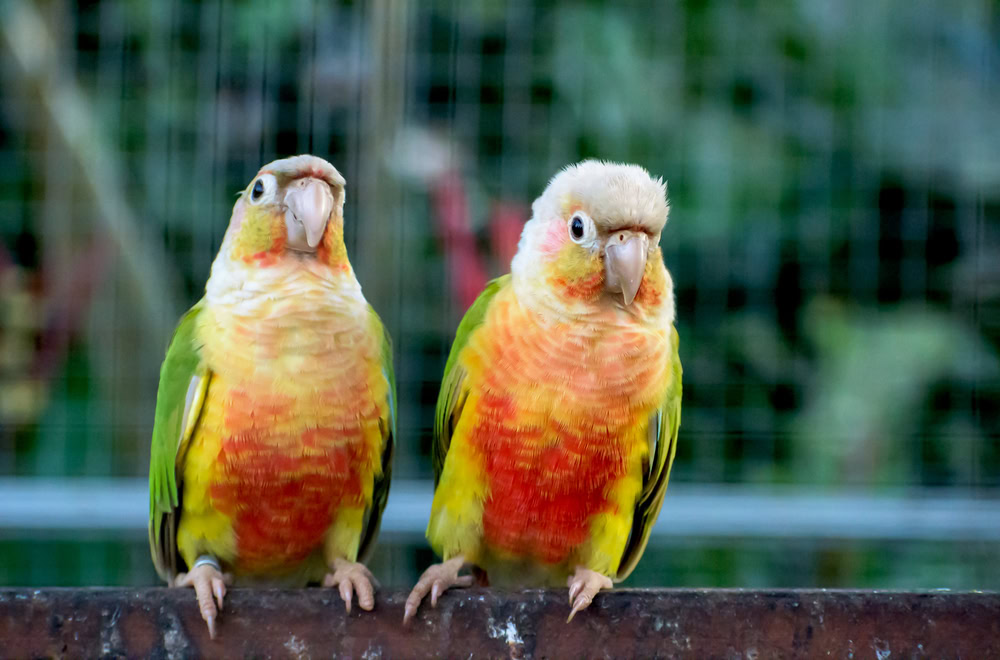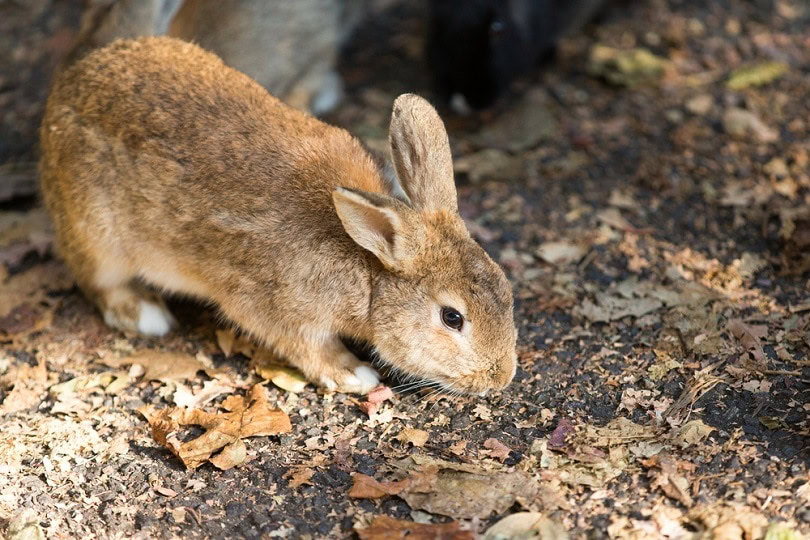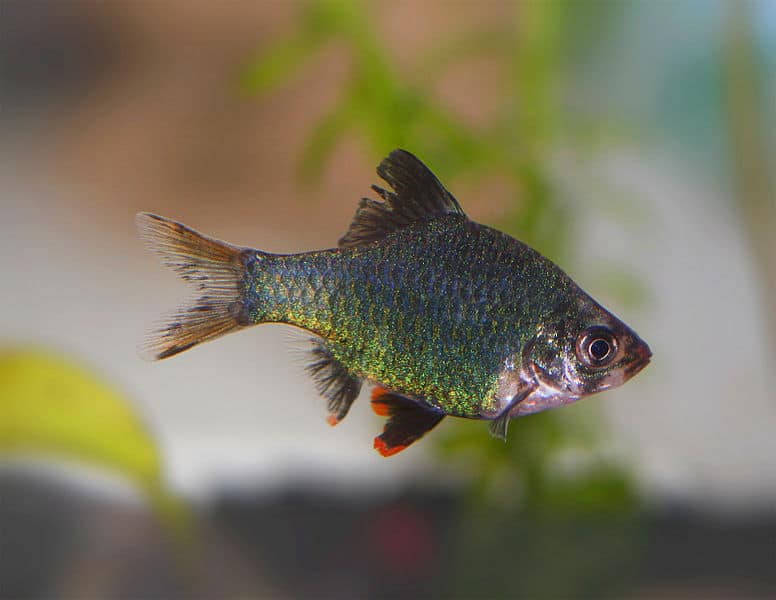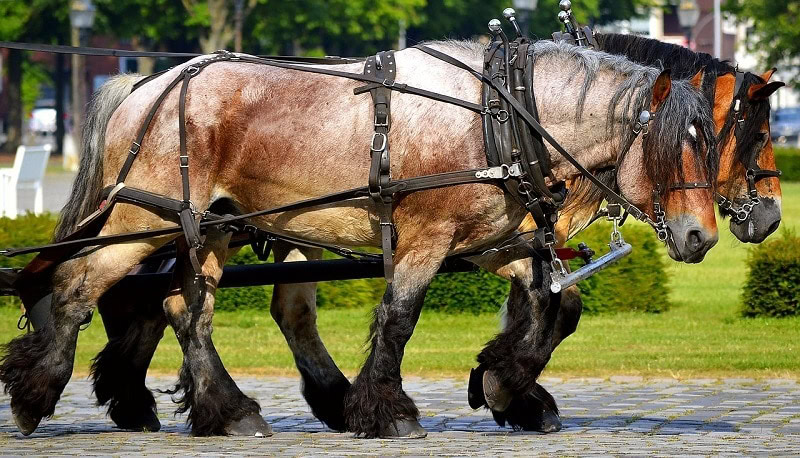VET APPROVED

The information is current and up-to-date in accordance with the latest veterinarian research.
Learn more »Click to Skip Ahead
The pineapple green cheek conure is a color variation of the green-cheeked conure (Pyrrhura molinae), with their unique coloration being the result of selective breeding. Being a color variation of the same species, their basic traits and temperament are about the same as the green-cheeked conure, providing valuable information for pet owners about their care. Let’s go over what that care involves just below.

Species Overview
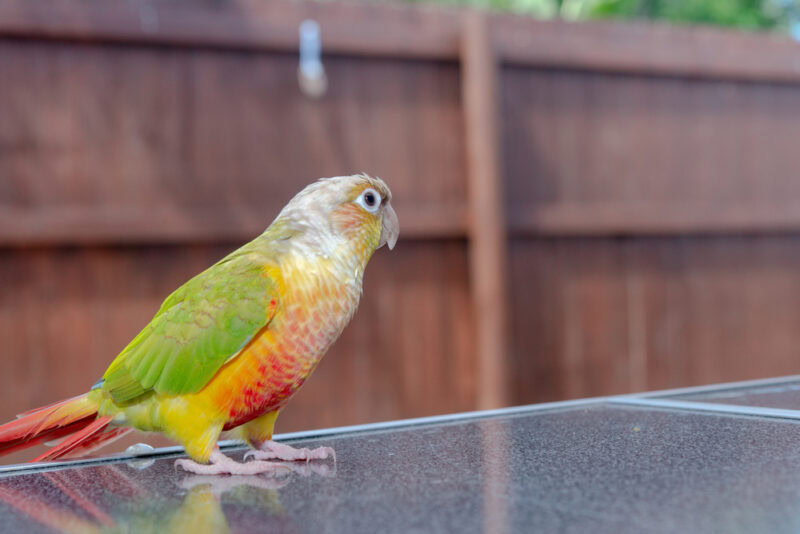
| Color: | Bright colors on the breast (often a combination of yellow and orange), a tan head, lime green back, an orange to dull-red tail |
| Size: | Approximately 10 inches (26 cm) |
| Weight: | Around 2.1–2.8 oz (60-80g) |
| Wingspan: | Approximately 5–5.5 inches |
Conures are fun avian companions. They are active and affectionate, suitable for novice and experienced pet owners. They are intelligent, like most parrots. After all, they are part of the same family. However, they require a lot of responsibility and commitment, so make sure you do plenty of research on these pets before bringing one home.

Pineapple Green Cheek Conure Characteristics
History and Natural Habitat
The green-cheeked conure is a South American parrot with habitats in Brazil, Bolivia, and Paraguay. Six subspecies exist, with specific home ranges for each. They are adaptable and live in various places, typically forests. These birds usually live in flocks of 10 to 20 at the treetop level, although larger flocks can be found where there is more food available.
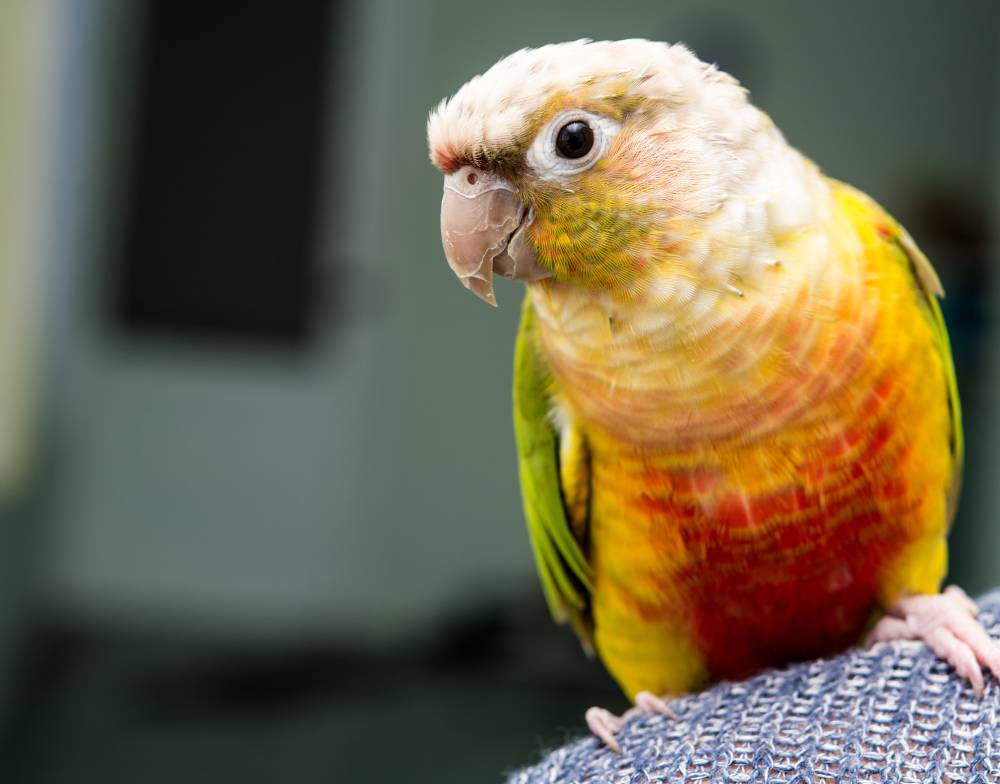
Things to Know When Owning a Pineapple Green Cheek Conure
Temperament
The pineapple green cheek conure is a friendly bird, but it depends on how much you handle your pet. This species thrives with regular interaction that provides mental stimulation and trust-building activities. This pet can be nippy if you don’t play with them, setting the stage for boredom and separation anxiety. Remember that birds are social animals, so you will need to keep them active with lots of things to do to prevent boredom behaviors.
Sounds, Speech & Vocalizations
The pineapple green cheek conure isn’t like other parrots that learn words and other vocalizations from people with repeated practice. It’s not that they aren’t vocal, though, as these birds screech and call like nobody’s business. That makes them an unsuitable choice for apartment dwellers. They are loud and will likely disturb your neighbors. However, they likely won’t develop the vocabulary of other parrots.
Pineapple Green Cheek Conure Appearance
Pineapple green-cheeked conures are a combination of two other color variations of the green-cheeked conure: the cinnamon and yellow-sided green-cheeked conures. They have a breast of bright yellow, orange (giving them their name), and sometimes green, a tan head, and lime green feathers on their back like a cinnamon green-cheeked parrot. The tail feathers are orange to dull-red in appearance (much like the yellow-sided green-cheeked conure).

Caring for the Pineapple Green Cheek Conure
Just because these birds are beautiful doesn’t mean that they should be pets to just anybody. Birds are a big commitment, as there is a lot that goes into their care, such as diet, cage requirements, exercise, and more.
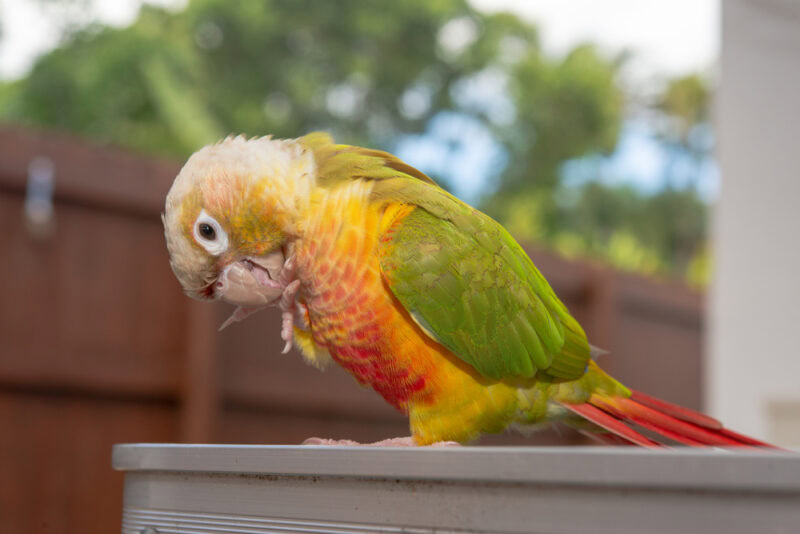
Diet & Nutrition
Nutrition is probably a greater concern with birds than other pets. Many species are opportunistic and may consume many items to fulfill their nutritional needs. That can make it challenging to replicate as pets. These birds consume nuts, seeds, fruit, and nectar in the wild. They eat what they find in their chosen habitats with a bounty of different foods.
You should offer your conure a pellet diet as the primary source since it covers most of what they need to survive and thrive. You can supplement it with vegetables, protein sources (such as nuts or eggs), and a small fraction of fruits. Changing out what you offer will even challenge your bird to figure out how to eat them, providing mental stimulation. Do note that seeds shouldn’t make up a significant portion of their diet, though, as they might start to only eat their favorites, which can lead to malnutrition.
Cage/Housing Requirements
We recommend getting the largest cage you can offer to put in the space you have set aside for your conure. A size of 24” x 24” x 24” is an absolute minimum. Having a larger space gives you room for toys and other interactive elements for your pet’s mental well-being. Playpens on the top of the cage offer a convenient way to fulfill this need and reduce cleanup for free-roaming pets. Also, make sure to look for products with 0.5-inch bar spacing. Place the cage away from drafts.
Also, note that birds are messy eaters, so consider this fact when deciding where to put it and how the area around it is easy to clean.
Exercise
We recommend letting your pineapple green cheek conure outside their cage for several hours every day for exercise and mental stimulation. Interaction with your pet is vital for their mental health. It’ll also reinforce the bond with your pet to reduce biting and other unwanted behavior. Remember that you’re also supplying your conure with social interactions, which is essential, as these are social birds.
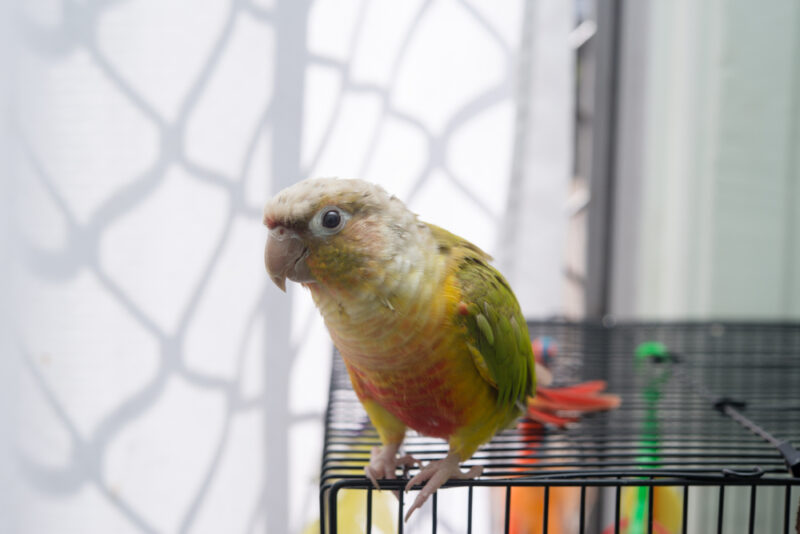
Health & Conditions
The pineapple green cheek conure is a relatively healthy pet if you meet the animal’s nutritional and enrichment needs. Consider the environment of this species and what it offers. We strongly urge you to find an avian vet before you get your pet. It’s an uncommon specialty, making it hard to find someone versed in these animals before you need them.
- Behavior issues due to inadequate socialization/training (biting)
- Overgrown claws
- Self-mutilation
- Bumblefoot
- Egg binding (females)
- Aerosol inhalation (especially from Teflon utensils)
- Malnutrition
- Atherosclerosis
- Arthritis
- Tumors

3 Little-Known Facts About the Pineapple Green Cheek Conure
1. The Green Cheek Conure Is a Species of Least Concern
The International Union for Conservation of Nature and Natural Resources (IUCN) doesn’t have a firm number on how many are left in the wild, but they are decreasing. Luckily, the populations aren’t fragmented.
2. Illegal Trade of Species Like the Green Cheek Conure Increases the Risk of Contacting Several Diseases, Including Psittacosis or Parrot Fever
Parrot fever isn’t the only issue, though. Other diseases include chlamydiosis and polyomavirus.
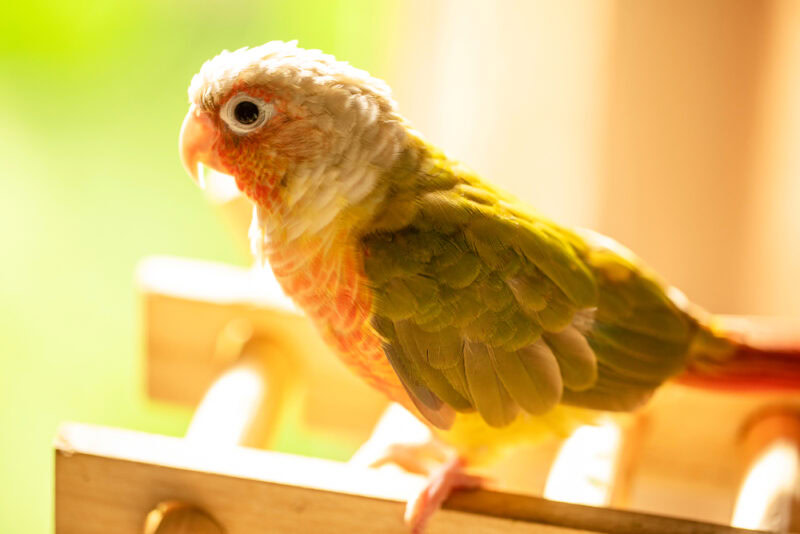
3. The Pineapple Green Cheek Conure Is the Offspring of Selective Breeding of the Yellow-Sided and Cinnamon Variations
Selective breeding brings new variants into the limelight. That’s the case with the pineapple green cheek conure, which capitalizes on color variations.

In Conclusion
The Pineapple Green Cheek Conure is a sweetie. This bird responds well to proper training, handling, and socialization. Avian pets are always a challenge, though, and this one is no exception. They require regular attention to make good pets, so you’ll need to ensure that you can dedicate a lot of your time to them in order to help them thrive in your home.
Featured Image Credit: M Anshar, Shuttersstock
